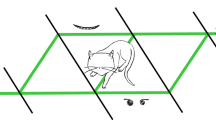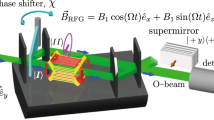Abstract
In 1975, two experimental groups have independently observed the \(4\pi \)-symmetry of neutrons’ spin, when passing through a static magnetic field, using a three-blade interferometer made from a single perfect Si-crystal (analogous to the Mach Zehnder interferometer of light optics). In this article, we provide a complete analysis of the experiment, both from a theoretical and conceptual point of view. Firstly, we solve the Schrödinger equation in the weak potential approximation, to obtain the amplitude of the refracted and forward refracted beams, produced by the passage of neutrons through one of the three plates of the LLL interferometer. Secondly, we analyze their passage through a static magnetic field region. This allows us to find explicit expressions for the intensities of the four beams exiting the interferometer, two of which will be interfering and show a typical \(4\pi \)-symmetry, when the strength of the magnetic field is varied. In the last part of the article, we provide a conceptual analysis of the experiment, showing that a neutron’s phase change, when passing through the magnetic field, is due to a longitudinal Stern–Gerlach effect, and not to a Larmor precession. We also emphasize that these experiments do not prove the observability of the sign change of the wave function, when a neutron is \(2\pi \) rotated, but strongly indicate that the latter, like any other elementary “particle,” would be a genuinely non-spatial entity.







Similar content being viewed by others
References
Aerts, D. (1999). The stuff the world is made of: Physics and reality. In Diederik Aerts, Jan Broekaert, & Ernest Mathijs (Eds.), The white book of ‘Einstein meets magritte’ (pp. 129–183). Dordrecht: Kluwer Academic Publishers.
Aerts, D. (2009). Quantum particles as conceptual entities: A possible explanatory framework for quantum theory. Foundations of Science, 14, 361–411.
Aerts, D. (2010). Interpreting quantum particles as conceptual entities. International Journal of Theoretical Physics, 49, 2950–2970.
Aerts, D. (2014). Quantum theory and human perception of the macro-world. Physics Review Letters, 5, 554. doi:10.3389/fpsyg.2014.00554.
Aerts, D., & Reignier, J. (1991). The spin of a quantum-entity and problems of non-locality. Helvetica Physica Acta, 64, 527.
Aerts, D., & Sassoli de Bianchi, M. (2014). The extended bloch representation of quantum mechanics and the hidden-measurement solution to the measurement problem. Annals of Physics, 351, 975–1025.
Aerts, D., & Sassoli de Bianchi, M. (2015a). Many-measurements or many-worlds? A dialogue. Foundations of Science, 20, 399–427.
Aerts, D., & Sassoli de Bianchi, M. (2015b). Do spins have directions? Foundations of Science,. doi:10.1007/s00500-015-1913-0.
Aharonov, Y., & Susskind, L. (1967). Observability of the sign change of spinors under \(2\pi \) rotations. Physical Review, 158, 1237.
Alefeld, B., Badurek, G., & Rauch, H. (1981). Observation of the neutron magnetic resonance energy shift. Physik B, 41, 231.
Ashcroft, N. W., & Mermin, N. D. (1976). Solid State Physics. Philadelphia: Holt-Saunders International Editions.
Aspect, A., Grangier, P., & Roger, G. (1982). Experimental realization of Einstein–Podolsky–Rosen–Bohm gedankenexperiment: A new violation of bell’s inequalities. Physics Review Letters, 49, 91.
Barut, A. O., & Bŏzic, M. (1990). On the interpretation of the spinor phase change in a magnetic field in neutron interferometry. Physics Letters A, 149, 431–437.
Barut, A. O., Bŏzic, M., Marić, Z., & Rauch, H. (1987). Tunneling of neutral spin-1/2 particles through magnetic fields. Physica B, 328, 1–10.
Bernstein, H. J. (1967). Spin precession during interferometry of fermions and the phase factor associated with rotations through \(2\pi \) radians. Physics Review Letters, 18, 1102.
Bernstein, H. J., & Zeilinger, A. (1980). Exact spin rotation by precession during neutron interferometry. Physics Letters A, 75, 169–172.
Bonse, U., & Hart, M. (1965). An X-ray interferometer. Applied Physics Letters, 6, 155.
Bonse, U., & Rauch, H. (eds.), Neutron interferometry. In Proceedings of an International Workshop held 5–7 June 1978 at the Institute Max von Laue–Paul Langevin, Grenoble (Clarendon Press, Oxford, 1979).
Cronin, A. D., Schmiedmayer, J., & Pritchard, D. E. (2009). Optics and interferometry with atoms and molecules. Reviews of Modern Physics, 81, 1051.
Eder, G., & Zeilinger, A. (1976). Interference phenomena and spin rotation of neutrons by magnetic materials. Physical Review, 34, 76.
Fermi, E. (1936). Motion of neutrons in hydrogenous substances. Foundations of Physics, 7, 13–52.
Gerlich, S., Eibenberger, S., Tomandl, M., Nimmrichter, S., Hornberger, K., Fagan, P. J., et al. (2011). Quantum interference of large organic molecules. Reviews of Modern Physics, 2, 263.
Gough, W. (1992). On the phase change of a spinor due to a rotation through \(2\pi \). European Journal of Physics, 13, 167–169.
Greenberger, D. M. (1983). The neutron interferometer as a device for illustrating the strange behavior of quantum systems. Reviews of Modern Physics, 55, 875.
Hasegawa, Y., & Rauch, H. (2011). Quantum phenomena explored with neutrons. New Journal of Physics, 13, 115010.
Hauge, E. H., & Støvneng, J. A. (1989). Tunneling times: A critical review. Reviews of Modern Physics, 61, 917–936.
Hegerfeldt, G. C., & Kraus, K. (1968). Critical remark on the observability of the sign change of spinors under \(2\pi \) rotations. Physical Review, 170, 1185–1186.
Kastner, R. E. (2013). The transactional interpretation of quantum mechanics: The reality of possibility. New York: Cambridge University Press.
Ma, X., Herbst, T., Scheidl, T., Wang, D., Kropatschek, S., Naylor, W., et al. (2012). Quantum teleportation over 143 kilometres using active feed-forward. Nature, 489, 269–273.
Martin, Ph A. (1981). Time-delay of quantum scattering processes. Acta Physica Austriaca, 23, 157–208.
Martin, Ph A, & Sassoli de Bianchi, M. (1992). On the theory of the Larmor clock and time-delay. European Journal of Physics, 25, 3627–3647.
Martin, Ph A, & Sassoli de Bianchi, M. (1994). Spin precession revisited. Foundations of Physics, 24, 1371–1378.
Mezei, F. (1986). La nouvelle vague in polarized neutron scattering. Physica B, 137, 295–308.
Mezei, F. (1988). Zeeman energy, interference and neutron spin echo: A minimal theory. Physica B, 151, 74.
Mezei, F. (1979). In U. Bonse & H. Rauch (Eds.), Neutron interferometry. Oxford: Clarendon.
Piron, C. (1990). Mécanique quantique: Bases et applications. Lausanne, Switzerland: Presses polytechniques et universitaires romandes.
Rauch, H. (2012). Neutron matter wave quantum optics. Foundations of Physics, 42, 760–777.
Rauch, H., Treimer, W., & Bonse, U. (1974). Test of a single crystal neutron interferometer. Physics Letters A, 47, 369–371.
Rauch, H., & Werner, S. A. (2015). Neutron interferometry: Lessons in experimental quantum mechanics (2nd ed.). Oxford: Oxford University Press.
Rauch, H., Zeilinger, A., Badurek, G., Wilfing, A., Bauspiess, W., & Bonse, U. (1975). Verification of coherent spinor rotation of fermions. Physics Letters A, 54A, 425.
Sassoli de Bianchi, M. (2011). Ephemeral properties and the illusion of microscopic particles. Foundations of Science, 16, 393–409.
Sassoli de Bianchi, M. (2012). From permanence to total availability: A quantum conceptual upgrade. Foundations of Science, 17, 223–244.
Sassoli de Bianchi, M. (2013). The delta-quantum machine, the k-model, and the non-ordinary spatiality of quantum entities. Foundations of Science, 18, 11–41.
Time-delay of classical and quantum scattering processes: a conceptual overview and a general definition, Cent. Eur. J. of Phys. 10, 282–319 (2012).
Weinfurter, H., Badurek, G., Rauch, H., & Schwahn, D. (1988). Inelastic action of a gradient radio-frequency neutron spin flipper. Physics B, 72, 195.
Werner, S. A., Colella, R., Overhauser, A. W., & Eagen, C. F. (1975). Observation of the phase shift of a neutron due to precession in a magnetic field. Physics Letters A, 35, 1053.
Zeilinger, A., & Shull, C. G. (1979). Magnetic field effects on dynamical diffraction of neutrons by perfect crystals. International Journal of Theoretical Physics, 19, 3957.
Acknowledgments
I would like to thank Gérard Wanders, professor emeritus of the University of Lausanne, for having suggested me, when I was a student, to explore the physics of neutron interferometry experiments. Many of the calculations presented in the first part of this article, describing the passage of a neutron through a LLL crystal, are drawn from some of his handwritten notes. No need to say, possible errors are solely my responsibility.
Author information
Authors and Affiliations
Corresponding author
Rights and permissions
About this article
Cite this article
Sassoli de Bianchi, M. Theoretical and Conceptual Analysis of the Celebrated 4π-Symmetry Neutron Interferometry Experiments. Found Sci 22, 627–653 (2017). https://doi.org/10.1007/s10699-016-9491-x
Published:
Issue Date:
DOI: https://doi.org/10.1007/s10699-016-9491-x




